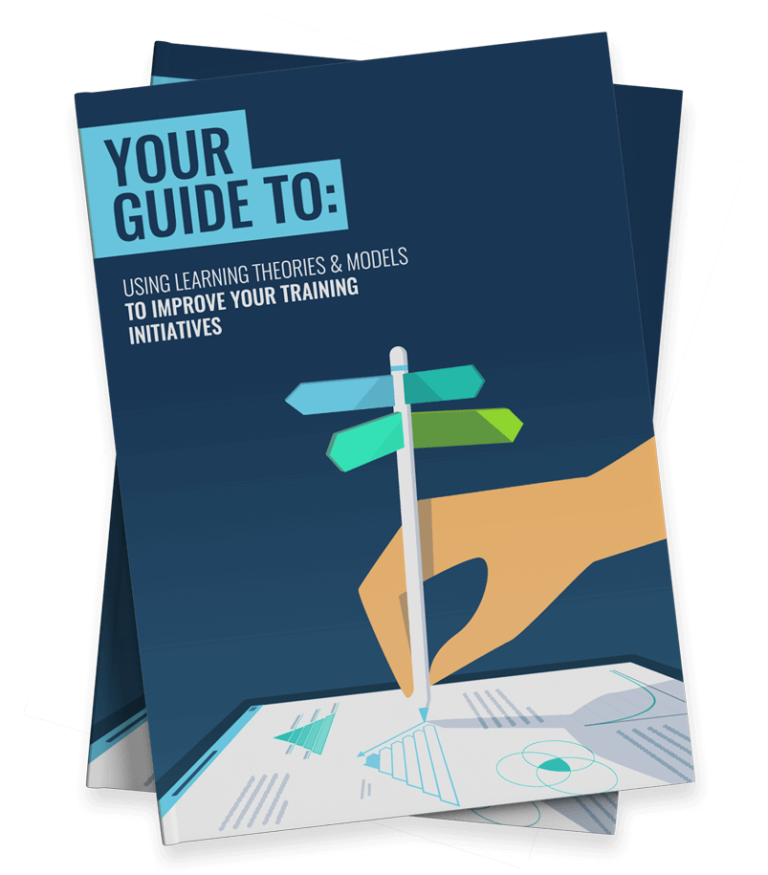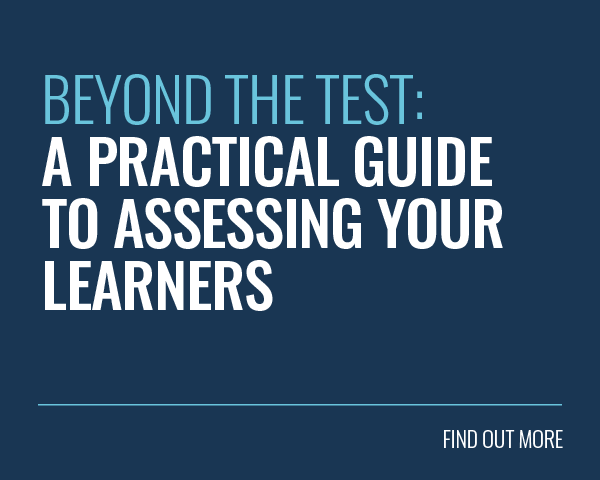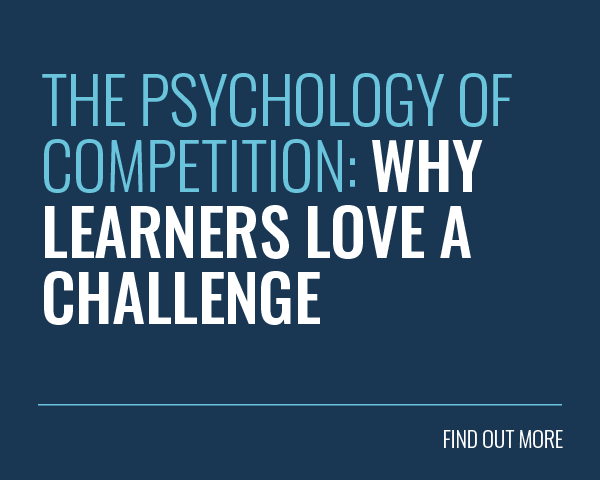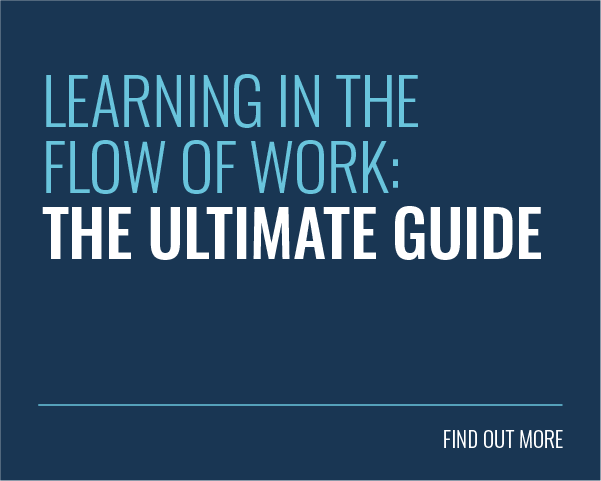Employee engagement is paramount to business success. But it has always presented two baffling problems! Luckily, the SCARF model is perfectly placed to help us better understand human behaviour and drive the kind of engagement we want to see.
First, it’s worth noting that you cannot simply demand engagement from your employees. If only you could! Then you could add it to job descriptions and raise it in annual reviews.
But, you can’t. In fact, any attempt to force engagement will often have the opposite effect and instead breed resentment. No, employees have to give it to you of their own volition.
And second, engagement is wreathed in mystery. Why one employee is disengaged whilst another seemingly near-identical employee is engaged can be incredibly hard to pin down. It’s like being trapped in an escape room without clues.
Luckily, David Rock and the SCARF Model can help! The SCARF Model is a five component framework that helps explain human behaviour as driven by social concerns.
In this article we’ll cover the SCARF Model in detail before showcasing how you can use it to create a highly engaged and productive workforce.
Are you ready? Then let’s rock!
Dr. David Rock
Dr Rock is a neuroscientist with an awesome name and an even better model of engagement. He helps people and businesses apply neuroscientific research to the workplace. To this end, he co-founded the Neuroleadership Institute and lectures at universities like Oxford.
Rock developed the SCARF Model back in 2008. It provides insights from the world of neuroscience to help you understand the conditions needed to engage employees.
As such, it will help you unwrap the mystery surrounding engagement. As a result, you can discern what’s actually needed to engage your workforce. This, in turn, helps you to impact your business positively.
What Is The SCARF Model?
The SCARF Model is a five component framework that helps explain human behaviour as driven by social concerns.
It summarises two key themes emerging from the vast and diverse field of social neuroscience. Firstly, that human motivation is largely driven by our desire to maximize rewards and minimize threats. And secondly, the brain considers our social needs to be as important as our basic needs for food and water.
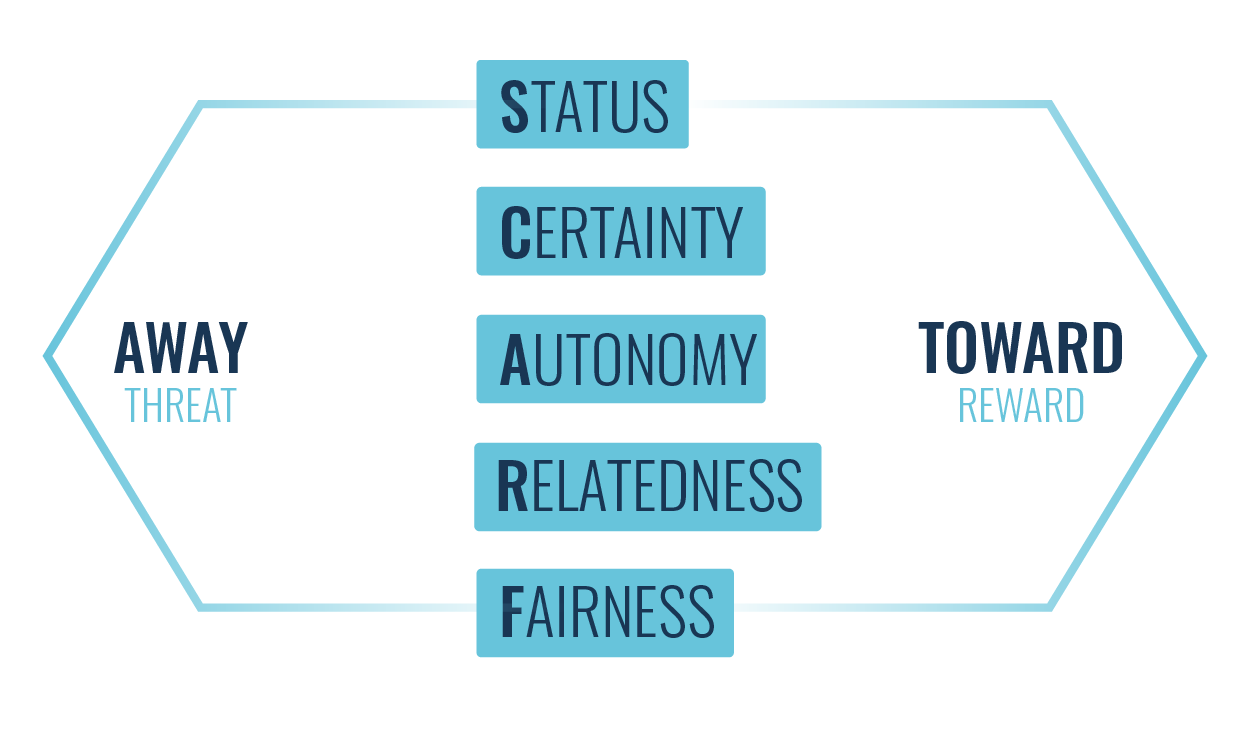
The model utilises five social drivers of human behaviour. The first initial of each category makes up the S, C, A, R and F of the SCARF model.
- Status: How you see yourself and how others see you.
- Certainty: How confident you can be of the future.
- Autonomy: How much control you have over your life.
- Relatedness: How connected you feel to others.
- Fairness: How reasonable you feel decisions involving you have been.
The SCARF Model allows us to classify and understand the social triggers that drive our behaviour. In the workplace, this model then allows us to design the right interactions that would maximise rewards and minimise threats for employees and teams.
The Foundational Thread of The SCARF Model
There is a driving principle behind the SCARF model which knits the whole framework together.
It’s the idea that the human brain has been organised to minimise threat and maximise reward.
- Threat: Threat is a shorthand way of describing things that make you feel a wide range of negative emotions. It includes everything from fear and sadness to anxiety and depression.
- Reward: Reward is the flipside of threat. It is a shorthand way of describing things that make you feel good emotions like happiness, through to creativity, curiosity, hope and love.
Put even simpler still, threats are the things you want to run away from and rewards are the things you want to run towards.
This idea is intuitive and easy to understand, but the ramifications are huge.
It means that throughout your life, you will have consistently made decisions that minimise any danger to you and maximise any good.
Threat State vs Reward State
Millions of years of evolution have trained our brains to behave very differently when responding to a threat vs responding to a reward.
Imagine, for a moment, that you are an early human living on a desert plain 200,000 years ago. Your brain would respond very differently to the threat of being chased by a tiger compared with the potential reward of obtaining fruit that is located high up in a tree.
In the first situation, all you need to do is run or climb. In the second some creativity and intelligent thinking might be needed.
Accordingly, here are some of the biggest differences between the threat state and the reward state:
Responding To Threats
- Blood is redirected from the brain to the muscles
- Less creativity
- Fewer insights
- Fewer ideas for new things to do
- Focus on the here and now
Responding To Rewards
- Increased blood flow to the brain
- More creativity
- Problem solving and insights
- Fresh ideas for things to do
- An ability to focus on bigger things
Employee Engagement And The SCARF Model
1. Neutral Engagement
When tackling engagement, the five dimensions of the SCARF Model is typically arranged into axes with a sliding scale. Neutral engagement means a state where your axes sit in the middle. As a result, the model would look like this:
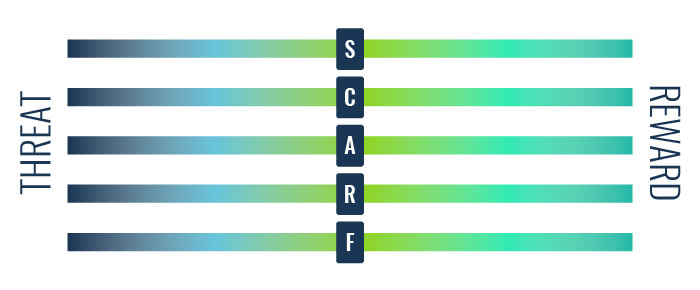
2. Disengagement
Imagine if each person had their own SCARF slider to represent how they felt. Each of the letters represents a different type of threat or reward. If all the sliders were on the left-hand side that would mean that the person would be in the threat state. That would make for an anxious, sluggish and possibly even depressed person. It would look like this:
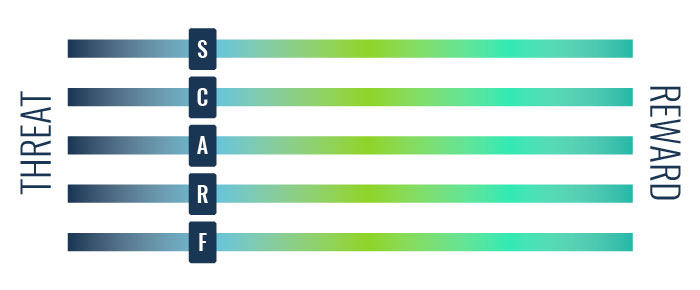
3. Engagement
But if you move all the sliders to the right, toward the reward state, these individuals are more energised, happier, curious and creative. As a result, your model would look like this:
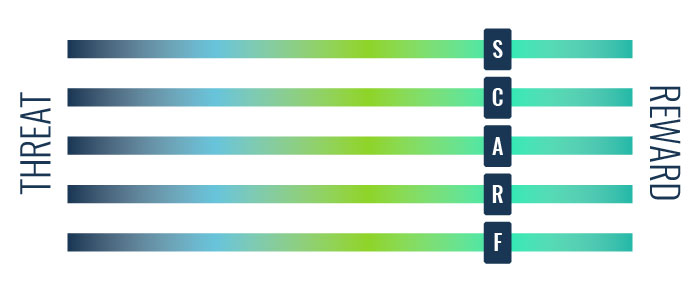
How Does The SCARF Model Relate to Engagement?
As we know, engagement can feel like one of those fussy plants that won’t grow unless the soil PH, sunlight and water levels are just right. But, when you find the right care routine, you will soon see it grow into a strong and healthy plant.
This growth can be interrupted if you stop watering it, or water it too much or repot it at the wrong time.
In engagement terms this means that all it takes for an engaged employee to become disengaged is for one of the sliders to drop back towards the left-hand side.
For instance, imagine if your engaged employee finds out that their team is at risk of redundancies. Suddenly their sense of certainty about the future would drop, like this:
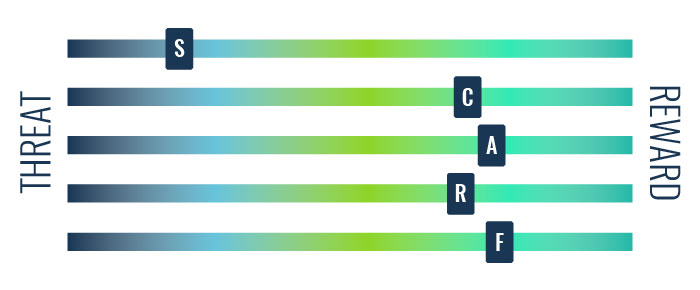
But imagine if they find out that their job is one of three at risk of redundancy. This would result their sense of certainty to fall through the floor. Suddenly, your model looks like this:
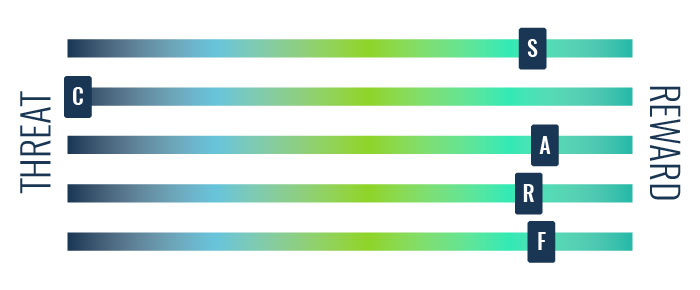
You can understand that an employee whose sense of certainty is out of kilter will no longer be engaged. After all, their mind will be on other things and they’ll be worrying about what’s in store for them.
And even if they find out their job remains safe, it can still take time for them to inch their way back to engagement.
The same dynamic applies to all aspects of the SCARF model. If you don’t connect with your colleagues, or you feel like you were passed over for a promotion unfairly, this will impact your engagement.
The same is true if you feel like people don’t respect you, or if you have no autonomy in your role. Any one of these factors can be a barrier between your employees and engagement.
How Can You Keep All Areas of SCARF Positive?
If the five SCARF elements are the foundation for engagement, then that means you need your employees’ SCARF sliders to be as right-leaning as possible. But how do you do that?
The frustrating truth is that there is no silver bullet solution. Life is beyond the control of even the most carefully managed corporate processes. Nobody knows what the future has in store, and nobody has complete control over their own life or over other people’s lives.
This all means that you can’t expect your employees to be engaged 100% of the time. That’s just not how life works. Luckily, the SCARF model can offer us some encouragement.
It tells us that employees simply want to be respected and treated fairly. They want to have a degree of certainty about the future and to have good relationships with their colleagues.
Similarly, employers need to support their employees’ professional development. Luckily, there are various approaches that help you highlight this successfully, from education stipends to internal training units.
If you offer this, then you can be confident you’re doing everything you can to build a strong foundation for employee engagement.
But once you have that foundation in place, what can you do to keep nudging the sliders further to the right? How can you go that one step further and engage your employees?
How Can Managers use The SCARF Model in the Workplace?

Who knew how much power these five letters held in driving human behaviour? Well, now you do, and it’s time to make them work for your organisation! Let’s see how one letter at a time…
1. Status
Status is linked to our relative importance in relation to others. The increase or decrease of status triggers the reward and threat circuits of our brain. As our status goes up, we are rewarded with dopamine, a happy hormone that elevates our mood.
On the other hand, a decrease in status creates anxiety. This is associated with an increase in cortisol levels. In turn, this explains how an employee’s sense of status in the workplace can also influence their general wellbeing.
Maximise Rewards By:
Improving an employee’s performance through learning and development initiatives are a way of raising their status. As such, a good training program catering to the different learning needs of your employees is a worthwhile investment.
With today’s hybrid and global workforce, the right learning solution is one where you can engage and unite teams in different locations and cultures. Moreover, giving your employees a chance to broadcast their learning achievements with others can also boost their status.
This is where an online technology platform can help. By providing your employees with the right learning platforms or tools, you encourage them to learn proactively, and showcase their progress with others.
You can also make your employees feel good by providing positive feedback for their efforts. Recognition and a sense of progress activate the reward circuits of your employees’ brains, encouraging them to work even harder to maintain or increase their status.
In addition, organizing social clubs or groups where your employees can practice social learning is another way to boost their status. After all, this gives them an opportunity to demonstrate their mastery of a topic.
Minimise Threats By:
Proceed with caution when giving advice or instructions to employees to prevent them from feeling ineffective at their tasks. Performance reviews are a minefield, where the threat states of employees can easily be triggered.
Thus, the key is to make sure your employees know that you’re their ally and not a foe out to diminish their achievements or crush their ego.
Letting your employees evaluate their job performance is also another way of breaking down any defence barriers. By doing so, employees feel less threatened and more open to suggestions for improvement.
2. Certainty
As rational beings, we naturally attempt to predict the future, so we can plan our next move. This is because the brain is hard-wired to crave certainty, being the pattern-recognition machine it is.
But constantly trying to figure things out can get pretty exhausting. This is why we are creatures of habit and routine. We need to conserve a good deal of our brain’s energy to deal with far more important things.
When unexpected events occur, this triggers a fight or flight response, elevating our stress levels. As a result, this can cloud our capacity for rational decision-making, affecting our performance overall.
Maximise Rewards By:
Increase certainty by establishing clear expectations and guidelines for your employees. Make sure that objectives and roles are clear from the get-go.
Communicating a definite agenda and time duration for meetings also helps to increase clarity across your team. This should allow your staff to more confidently prepare and plan, based on the information they receive.
When implementing a new initiative, assure employees and stakeholders of its intended impact and how it will affect the concerned parties. You can also increase certainty by clearly communicating the timelines of your new initiative.
Minimise Threats By:
Big change brings big uncertainty. This is especially apparent during organisational restructures, which can increase anxiety for employees.
As such, you should attempt to minimize threats by being transparent and sharing information with your team.
Moreover, managers may benefit from scenario planning, a strategic exercise to manage future events. Break down complex projects into manageable chunks and create clear timelines and tasks.
3. Autonomy
Autonomy relates to our ability to influence outcomes or act according to our own values and interests. The degree of control we have over our environment strongly links to our brain’s threat and reward centres.
When employees feel a loss of control, they become stressed which reduces their capacity to act efficiently. Hence, helping each member of your team improve their sense of autonomy can increase their wellbeing. On the other hand, employees who are micromanaged can feel a reduction in autonomy, which is likely to provoke a threat response.
Maximise Rewards By:
Providing employees with room to tailor their learning and development programme is a good way to increase their agency. You can do this by providing them with a learning platform. This will allow them to set their own learning objectives and explore courses at their own pace.
Did you know that even the little freedoms you provide your employees can go a long way? Particularly, the freedom to organize one’s workspace, set one’s own working hours, and determine one’s own performance goals (within established policy) can also help increase autonomy.
Minimise Threats By:
While the formation of teams can improve innovation and productivity, conflicts can arise if not properly managed. Minimize stress by ensuring that each employee has their own tasks with ownership and accountability.
You should also ensure that employees are actively engaged and involved in setting, shaping and monitoring overall team objectives. By giving each employee the freedom to contribute and shape project outcomes, you can protect their autonomy, while reaping the full benefits of a happy and collaborative team!
4. Relatedness
Relatedness focuses on how connected or safe we feel with others. It also concerns our sense of belonging and affinity in a particular group. This is a driver in many types of teams. When we form bonds with people, our brain’s reward centre lights up. Oxytocin is produced, which encourages collaboration and trust.
Hence, On the other hand, strangers or intimidating people may be perceived as threats. This is due to the lack of enough information or affinity we have with them. As a result, our defensive walls go up, which can block feelings of empathy.
Our social bond with others is a primary need that contributes to our wellbeing and ability to function optimally. As such, it is essential that employees feel connected with their colleagues and the company at large, if they are expected to perform at their best.
Maximise Rewards By:
Increase relatedness by promoting safe connections between employees and among teams. You can do this by encouraging positive interactions through team-building activities. Explore channels that can increase interaction and engagement, such as gamification and social learning.
This sets up a knowledge sharing culture where teams can learn from each other and work together on common quests or goals.
Similarly, organizing clubs or groups where your employees can join and network is also a good way to encourage social connections. This allows them to discover common interests with other colleagues, promoting trust and closer bonds.
Providing a proper onboarding programme for new employees can also increase their sense of belonging to your organisation. An effective onboarding strategy is one where employees can get to know different teams and familiarize themselves with your organisational culture straight away.
Minimise Threats By:
With the evolving demands of the modern day workplace, remote working has emerged as one of the key challenges facing managers today. With the absence of the face-to-face contact necessary to promote strong social bonds, team-building strategies can help to keep remote teams together.
Adding cultural diversity to your teams is an essential pillar of business success. But in the wrong environment, it can be a hotbed for misunderstandings and biases in your global (or virtual) workplace.
To minimize threats, you should encourage interactions where your teams can share their interests. Do not hesitate to organize non-work meetings where team members can simply hangout and get to know each other.
5. Fairness
Fair exchanges are intrinsically rewarding. This explains voluntary duty, as volunteering increases people’s sense of fairness in the world. Unfair exchanges generate a strong threat response.
In fact, when faced with a sense of injustice, the amygdala is activated. This is the area of the brain associated with dealing with intense emotions like disgust. As a result, our capacity for empathy is often disabled when we perceive someone or something as being unfair.
Maximise Rewards By:
Meeting expectations or following up on the promises you’ve made to your employees increases their sense of fairness. Similarly, you should seek to provide compensation that matches their capabilities and competency.
Don’t hesitate to acknowledge and reward employees for meeting certain goals or targets. This helps employees to feel validated for their efforts, increasing their sense of fairness. In addition, practicing diversity and inclusion within today’s workplace is a must, as all employees deserve to be treated fairly as individuals.
Minimise Threats By:
Establish clear ground rules and the desired values you want your team to follow. By doing so, team members understand what is expected of them and have clear guidance on correct conduct.
Similarly, this gives them a clearer sense of how to treat their colleagues. By creating and promoting a shared culture built on common values and rules, you can help bring teams closer together.
There you have it! The S-C-A-R-F secrets of top managers for employee productivity! But hold on, there’s one final tip that will really turbocharge your engagement strategy.
Epic Meaning
Epic Meaning is about being a part of something bigger than yourself. It’s about having lofty goals to make the world a better place.
Hence, let’s look at how epic meaning can impact the SCARF model, one thread at a time:

- Status: Nothing is better for your perception of yourself, or for other people’s’ perception of you than doing something meaningful.
- Certainty: By solving problems you make the world a more certain place. This helps remove some of that risk that makes life scary.
- Autonomy: Making the world a better place is the ultimate expression of autonomy. You are making choices and the choices you make are solving problems.
- Relatedness: No meaningful change can be made by one person alone. Teams who are working together to achieve the same goals are more tight-knit than any other.
- Fairness: Making the world a better place means making it a fairer place as well.
This may sound like high-mindedness, but the figures back us up. Studies consistently demonstrate that businesses with a vision for a better world (or a mission), achieve more than businesses that exist to make money and beat the competition.
Final Words
The SCARF Model helps you see engagement for what it really is. You can see past the confusion and perceive the true fabric of engagement. And it’s very, very simple.
After all, who doesn’t want to be respected and treated fairly, to have a degree of certainty about the future and to have good relationships with colleagues?
We all want to have an impact on the world. To leave it a better place than we found it. This gives us a real sense of purpose. And what’s more engaging than that?
The SCARF Model is just one framework you can use to improve learner engagement and training outcomes. Discover the 15 key theories and models you have to know through our ‘Learning Theory Guidebook‘. Check it out now!

